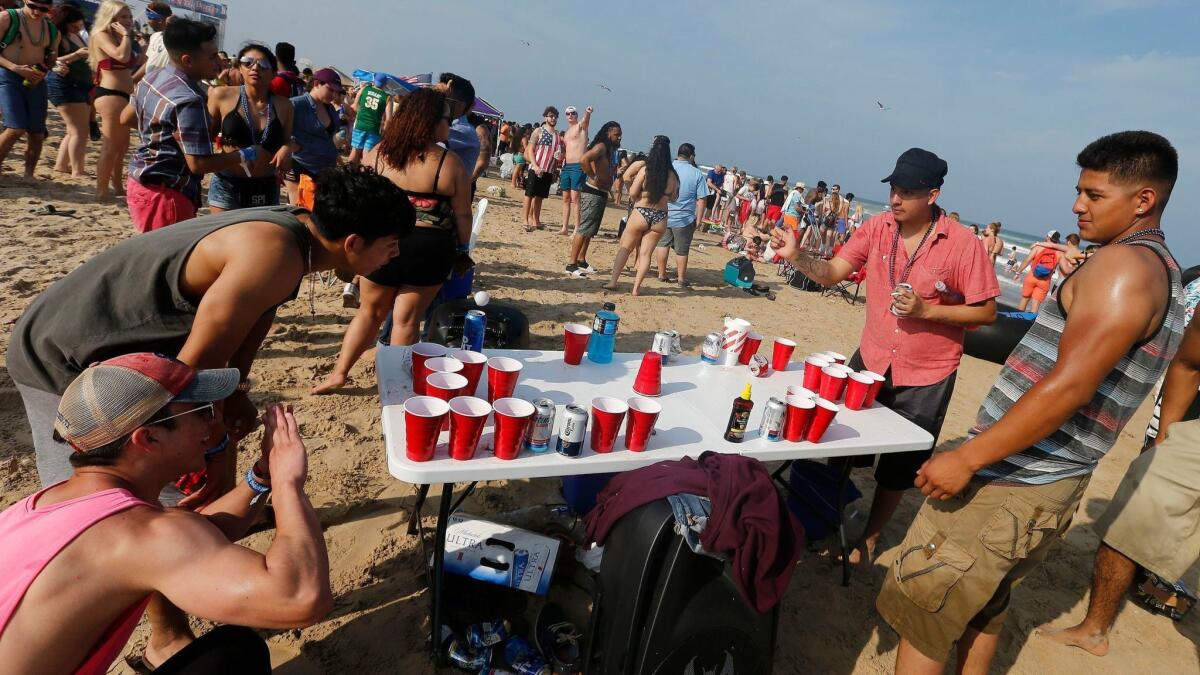Heading for spring break? What students need to know, and what parents must know

Here are words that strike fear into the hearts of parents around the world: “Mom and Dad, I’m going to spend spring break in [fill in the name of a destination that is not your home address] with [fill in the name of your child’s peers you kind of know], and we’re going to be staying in [fill in the name of a skeevy-sounding hotel or the home of someone’s first cousin once removed].”
You’ve worked to make your child independent, to help him or her develop critical thinking skills, to encourage a spirit of adventure.
What could go wrong?
Oh, maybe something like this, heard by my sister in a frantic phone call from daughter No. 4 on spring break: “Mom, I need money to get [name of best friend] out of jail.”
That was a U.S. destination. The complexities multiply if it’s a foreign destination. Here are some topics you and your child (and really, any traveler who wants to be well informed) need to consider before taking the trip abroad:
— Safety of the destination. Before agreeing to a student’s trip, please consult the State Department’s country-specific information at lat.ms/statecountryinfo.
The State Department this year revamped the way it characterizes a destination’s safety. Each country has a numerical rating. A 1 rating is “exercise normal caution” and 4 is “do not travel.”
Peru, for instance, is a 1. But don’t stop reading there.
Read on and you’ll come across this important bit of information: “Peru is now enforcing its regulation that U.S. citizens must possess a passport valid for at least six months beyond the date of arrival to Peru. If your passport does not meet this requirement, you may be refused boarding by the airline at your point of origin or while transferring planes.”
If travelers don’t have that much time on their document, they “may be refused entry and returned to the United States.”
Also, take a look at the interactive maps, said Michelle Bernier-Toth, acting deputy assistant secretary for Overseas Citizens Services. Those will come in handy for such destinations as Mexico, where the maps contain gradations of risk.
— Emergency steps just in case. Start with this, which is also part of the State Department’s pages: If your child is going abroad, make sure he or she has the embassy and/or consulate information (address, phone, web) with him, Bernier-Toth said. If trouble finds him or her (lost passport, for instance), your kid may need a helping hand. Remember, though, that an embassy or consulate can help in many but not all situations. If your traveler has a visa issue, State may not be able to help. And it notes with firmness that it cannot get U.S. citizens out of jail.
Make sure the traveler has the proper documentation, especially if the destination requires a visa. The State Department’s country information tells you whether you need one; for more info, consult the country’s embassy page.
— A communications plan. Discuss when you will hear from your child, and settle on how (Apps such as WhatsApp? Skype? Text?), Bernier-Toth said.
Also discuss enrolling in the Smart Traveler Enrollment Program, or STEP, at step.state.gov. Maybe letting the State Department know where you are feels too Big Brother-ish. OK, maybe it is. But if your child doesn’t check in, you can turn to State for help because it will have the itinerary.
The enrollee also will receive updates on current alerts or concerns. A parent can enroll too and receive that same information, Bernier-Toth said.
— The perils of drugs and alcohol. Recreational marijuana may be legal in California but it’s not in every state, and it’s definitely not in many foreign countries.
Here’s a chilling line from State’s country information on Indonesia, chosen at random: “If you are convicted of possession, use, or trafficking of illegal drugs in Indonesia, you can expect heavy fines and long jail sentences, including the death penalty.” Heavy fine indeed.
As for alcohol, it is, perhaps, a vain hope that no alcohol will pass your child’s lips, but could there be a designated sober person if your student is traveling in a group? There have been concerns about tainted alcohol being served in Mexico, and someone needs to keep his or her wits about them, regardless of the destination.
— Insurance. Please. “We strongly encourage travelers of any age … to obtain both medical travel insurance and evacuation insurance,” Bernier-Toth said.
Travel comparison site Squaremouth notes that spring breakers can buy themselves 24-hour assistance with a policy.
As with all insurance, there are exclusions, and a recent statement from Squaremouth included these sobering words: “It’s no secret that many college students will be drinking alcohol while on their vacation, especially if their destination’s drinking age is lower than it is at home.
“If a traveler needs emergency medical treatment while on their spring break trip, travel insurance will cover them, unless they’re intoxicated. If their medical notes indicate that they were drinking past the legal limit, the claim will be denied.”
So cheers. We don’t mean to ruin anyone’s fun. Just know where and when to draw the lines, keep in touch with home and take an extra credit card (hidden in your possessions) with quite a bit of credit on it and maybe a cash advance feature just in case you need, you know, bail money for your best friend.
Have a travel dilemma or inquiry? Write to travel@latimes.com. We regret we cannot answer every inquiry.
More to Read
Sign up for The Wild
We’ll help you find the best places to hike, bike and run, as well as the perfect silent spots for meditation and yoga.
You may occasionally receive promotional content from the Los Angeles Times.







